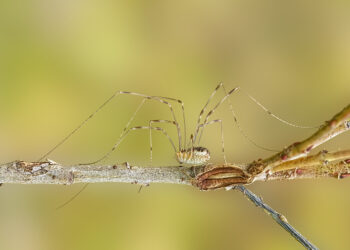
In a quarry in south-eastern Brazil, a small but exquisite skull lay hidden for over 80 million years. When researchers finally unearthed the fossil, they were stunned by what they saw — a nearly complete, three-dimensional bird-like skull, preserved with a clarity rarely found in fossils from this era.
As paleontologist Dr. Guillermo Navalón of Cambridge’s Department of Earth Sciences recalls, “I was awe-struck when I first saw the fossil. It was so incredibly well-preserved and it looked so much like a modern bird.”
The fossil, newly named Navaornis hestiae, belongs to the long-extinct enantiornithines, or ‘opposite birds.’ Although they shared many features with modern birds — such as feathers and the ability to fly — they diverged early on from the lineage that led to today’s birds. These were an ancient group that coexisted with dinosaurs. Yet, they never survived the mass extinction event that followed the devastating asteroid impact 65 million years ago.
Unlike most enantiornithine fossils, which are often found flattened beyond recognition, this discovery provides a rare, three-dimensional glimpse.
This pristine preservation allowed the team to digitally reconstruct the bird’s brain and fill a 70-million-year void in scientists’ understanding of how birds evolved their unique neurological traits. This fossil fills that gap between the 150-million-year-old Archaeopteryx, one of the earliest bird-like dinosaurs, and the birds we see today.
In the process, this research has opened new windows into how the skulls and brains of modern birds may have evolved.
A one-of-a-kind fossil

The discovery site, a small quarry in Presidente Prudente, São Paulo State, is a hidden treasure trove of Late Cretaceous fossils. Paleontologist William Nava first discovered this site and the fossils, leading to the fossil’s eventual naming in his honor. Any connection between the new species’ name and Dr. Navalón is purely coincidental, as he jokingly points out.
“I am the lead author of the investigation and my name is Guillermo (Spanish for ‘William’) Navalón. I guess at some point I thought some people might think I named the species after me! But obviously I would never do that,” Navalón told me in an e-mail.
The fossil’s preserved skull structure was reconstructed using micro-CT scans, revealing fascinating details about Navaornis’ brain anatomy. The scans revealed an almost perfect intermediary between Archaeopteryx and modern birds, like a missing puzzle piece.
Despite its archaic lineage, its skull structure bears an uncanny resemblance to that of modern birds. The toothless beak, large eye sockets, and vaulted cranium are strikingly similar to today’s avian species. Yet, deeper analysis revealed that it retained several ancient features, such as a maxilla-dominated snout and an inflexible palate — traits long lost in modern birds.
This paradoxical combination led the researchers to compare it to a “Rosetta Stone” of bird evolution.
“Just like the historical stone allowed us to connect hieroglyphs with Ancient Demotic Greek, in the middle is Navaornis,” Navalón told ZME Science.
An intermediate brain

Navaornis had a larger cerebrum than Archaeopteryx, hinting at more advanced cognitive abilities. However, other regions, such as the cerebellum, were less developed, suggesting that this bird was still refining the complex flight control mechanisms seen in today’s avian species.
This has led to some intriguing speculation about Navaornis’s capabilities. Could it have exhibited behaviors akin to today’s tool-using or socially complex birds? “Our knowledge of the relationship between brain form and behavior is still very incipient,” admits Dr. Navalón. However, he hints at the possibility that its cognitive abilities were more advanced than those of its contemporaries. The fossil’s oversized labyrinth, an organ crucial for balance, hints at exceptional spatial awareness—perhaps a precursor to the agile flight patterns seen in modern birds.
“The telencephalon (cerebrum) of Navaornis is intermediate in relative size between Archaeopteryx and modern birds. This area in mammals contains the neocortex, and in modern birds represents a functionally equivalent area, and intervenes in highly complex cognition, we could speculate that the cognition of Navaornis might have been intermediate too between these two points,” Navalón added.
The discovery of Navaornis raises more questions than it answers. For instance, why did enantiornithines like Navaornis develop certain ‘modern’ traits independently of their crown bird relatives? Was this convergence driven by similar environmental pressures, or is it a sign of parallel evolution in isolated lineages? These mysteries have ignited a new wave of research, with Dr. Navalón’s team eager to explore how brain structures evolved in birds that bridged the gap between the early avians and their modern descendants.
“Multiple and too many to list!” exclaims Dr. Navalón when asked about the questions this discovery has sparked. Among them is the enigma of the enlarged labyrinth. “It means something, but we do not know yet what,” he says, hinting at new studies in the pipeline.
A Glimpse Into the Evolution of Bird Intelligence
This discovery adds a crucial piece to the puzzle of avian evolution. Modern birds are known for their sophisticated behaviors, from tool use to complex communication. Understanding the roots of these traits could transform our understanding of how intelligence evolved not just in birds, but across the animal kingdom.
Navaornis serves as a crucial stepping stone in this journey. By filling in the gaps between early bird species like Archaeopteryx and today’s diverse avian fauna, it reveals how nature iteratively refined the avian brain. As Dr. Navalón concludes, “There is still a lot of new fossils to find and a lot of scientific comparative work to do before we can understand fully the origination of modern bird brains and cognition.”
The findings appeared in the journal Nature.






